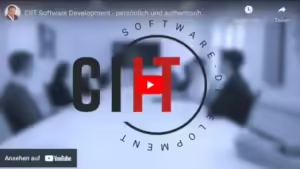Introduction
In a world in which customized software solutions are becoming increasingly important, many interested parties are wondering how the development process works at a professional software company. CIIT Software, as an experienced provider in this area, attaches great importance to a transparent and customer-oriented project process. In this presentation we would like to give interested parties a detailed insight into how a development project at CIIT is typically designed. From the first non-binding workshop to the final delivery of the software, every step is carefully planned and carried out in close coordination with the customer. The aim is to create a clear understanding of our approach and the associated benefits that differentiate CIIT Software from other providers.
Step 1: Free introductory workshop
The first step of every project at CIIT Software is a free workshop with the customer. The basic requirements are discussed here without the customer having to submit a written concept. Important parameters of the project are examined and initial technical implementation options are discussed. This workshop serves as a basis for further planning and is both free of charge and non-binding.
Step 2: Create a roadmap
Based on the results of the workshop, the CIIT team creates a detailed roadmap or roadmap. This includes the time frame, the estimated costs and a description of how the technical implementation and the design of the user interface should be carried out. Examples from previous successful projects are used to give the customer an idea of the application to be developed.
Step 3: Discussion and adjustment
The developed plan is discussed with the customer in another workshop. Adjustments and fine-tuning can be made here to ensure that all of the customer's needs and requirements are taken into account.
Step 4: Start implementation
After the CIIT team and the customer have agreed on the procedure, the first step of implementation is planned and commissioned by the customer. After just 3-4 weeks, the team presents a first executable version of the software.
Step 5: Iterative development and feedback
This first version of the software is presented to the customer, who can then provide feedback. This feedback is taken into account in subsequent iterations to continuously improve and develop the software. This process is repeated until the software has achieved the defined range of functions.
Step 6: Transparent processes and customer integration
Throughout the entire project, the customer has insight into planning, working time recording, quality assurance measures and project progress. The customer also receives access to the integration environment in which the current version of the software can be tested and assessed.
Conclusion
The project process at CIIT Software is characterized by a customer-oriented, transparent and iterative approach. The customer is actively involved in the development process and can always understand and influence the progress. This ensures that the end result meets the customer's requirements and expectations.





